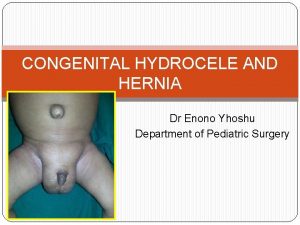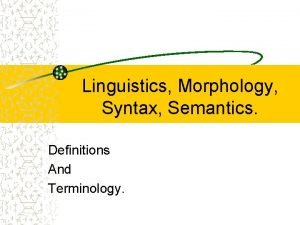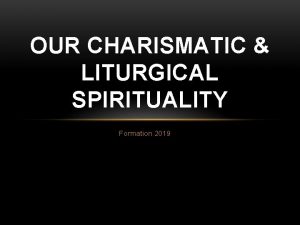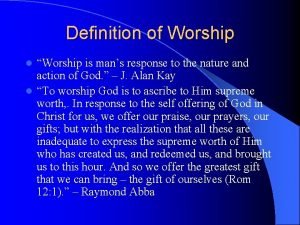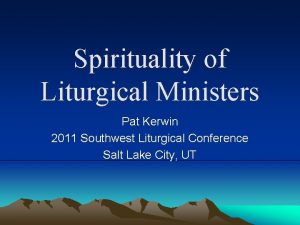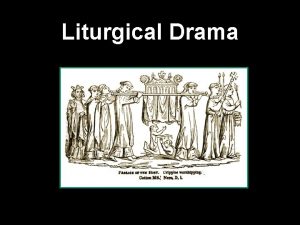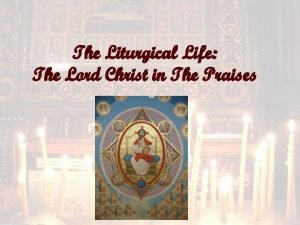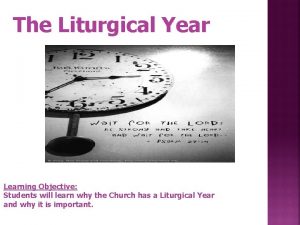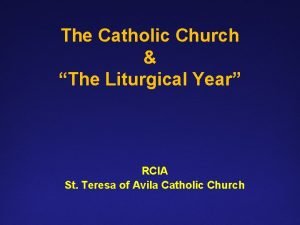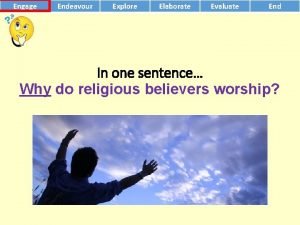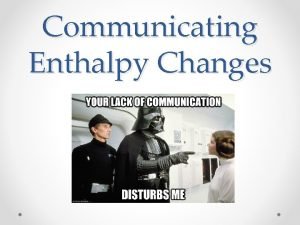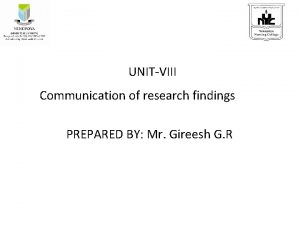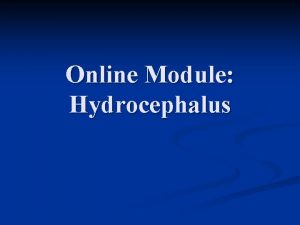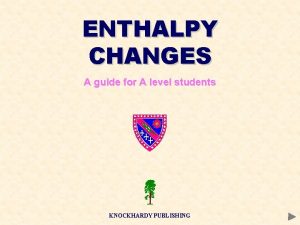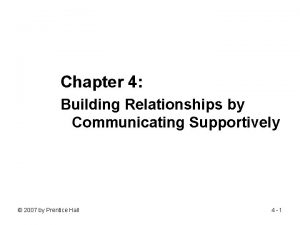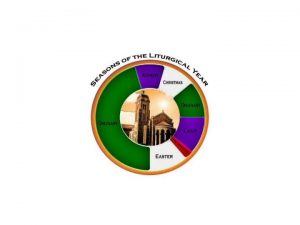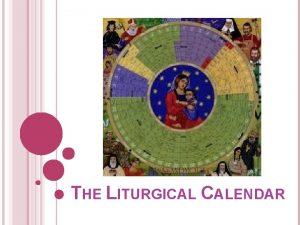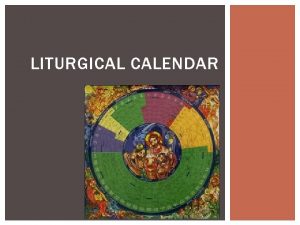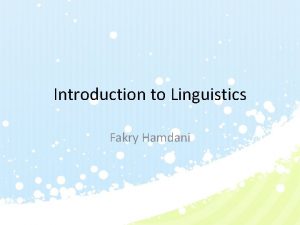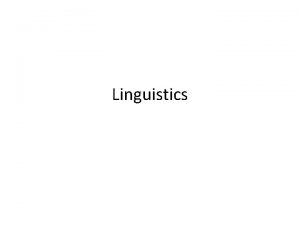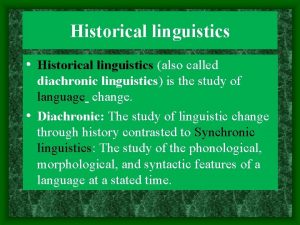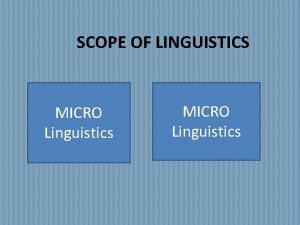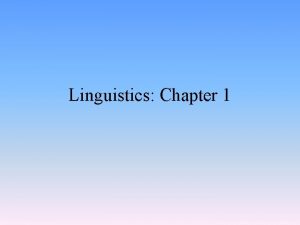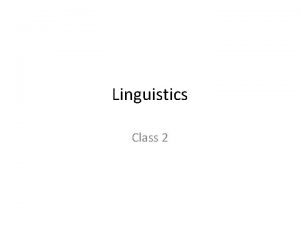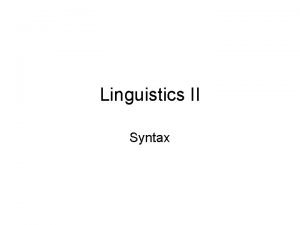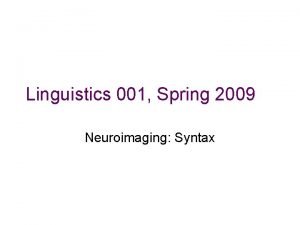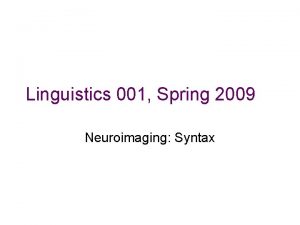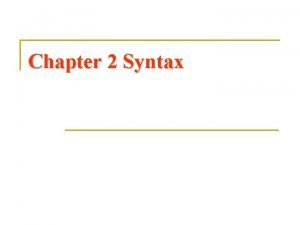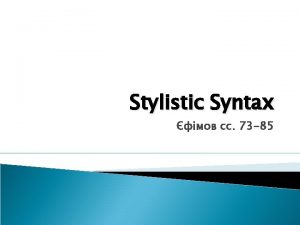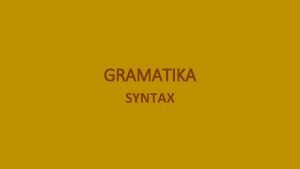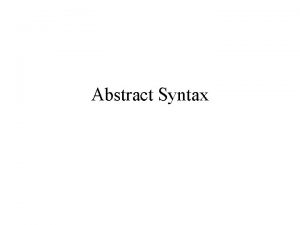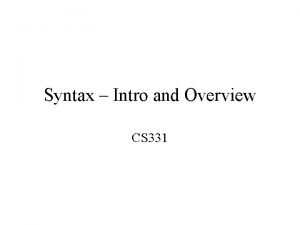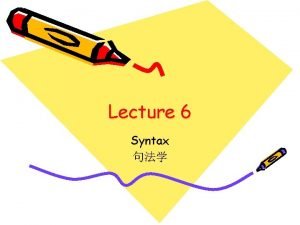Liturgical linguistics The syntax of communicating with the


























- Slides: 26

Liturgical linguistics: The syntax of communicating with the super-human agent in Judaism Tamás Bíró Budapest, Hungary birot@nytud. hu, biro. tamas@hebraisztika. hu, birot@let. rug. nl, http: //www. let. rug. nl/~birot Origins of Religion, Cognition and Culture Aarhus, January 5, 2006 1 / 26 Tamás Bíró: Liturgical linguistics birot@nytud. hu, birot@let. rug. nl

Overview • Prayer as communication with SHA • Constituents in syntax • Structure of Jewish liturgy – a generative linguistic approach • Blessings – why? • Conclusion Origins of Religion, Cognition and Culture Aarhus, January 5, 2006 2 / 26 Tamás Bíró: Liturgical linguistics birot@nytud. hu, birot@let. rug. nl

Overview • Prayer as communication with SHA • Constituents in syntax • Structure of Jewish liturgy – a generative linguistic approach • Blessings – why? • Conclusion Origins of Religion, Cognition and Culture Aarhus, January 5, 2006 3 / 26 Tamás Bíró: Liturgical linguistics birot@nytud. hu, birot@let. rug. nl

Prayer as communication (1) • A line in the Cognitive Science of Religion: – Religious phenomena are related to their non-religious counterparts – But also involving super-human agents (SHA) • Methodology: – Make also use of the methodology describing their non-religious counterparts Origins of Religion, Cognition and Culture Aarhus, January 5, 2006 4 / 26 Tamás Bíró: Liturgical linguistics birot@nytud. hu, birot@let. rug. nl

Prayer as communication (2) • Prayer: – Communication with super-human agents (SHA) – Hence: employ results and models from linguistics • Compare to Mc. Cauley and Lawson (2000)’s model of rituals: SHA Origins of Religion, Cognition and Culture Aarhus, January 5, 2006 5 / 26 Tamás Bíró: Liturgical linguistics birot@nytud. hu, birot@let. rug. nl

Prayer as communication (3) • I claim that prayer is: – A form of language / communication – Organized along the (cognitive, mental and social) principles used by language in general – Has an overall structure known from language – Can be analysed using linguistic methodology … otherwise, it could not be evolutionarily stable • NB: for Mc. Cauley and Lawson (2000) prayer is not a ritual. Origins of Religion, Cognition and Culture Aarhus, January 5, 2006 6 / 26 Tamás Bíró: Liturgical linguistics birot@nytud. hu, birot@let. rug. nl

Overview • Prayer as communication with SHA • Constituents in syntax • Structure of Jewish liturgy – a generative linguistic approach • Blessings – why? • Conclusion Origins of Religion, Cognition and Culture Aarhus, January 5, 2006 7 / 26 Tamás Bíró: Liturgical linguistics birot@nytud. hu, birot@let. rug. nl

Constituents in syntax (1) • Similar distribution same category: I loved John loved I kissed that girl. • Movement: That girl I I Origins of Religion, Cognition and Culture Aarhus, January 5, 2006 loved. 8 / 26 that girl. Tamás Bíró: Liturgical linguistics birot@nytud. hu, birot@let. rug. nl

Constituents in syntax (2) • Heads and complements S NP VP subject V NP object I John Origins of Religion, Cognition and Culture Aarhus, January 5, 2006 loved kissed 9 / 26 that girl Marry Tamás Bíró: Liturgical linguistics birot@nytud. hu, birot@let. rug. nl

Constituents in syntax (3) • Movement S NP that girl I Origins of Religion, Cognition and Culture Aarhus, January 5, 2006 VP V NP loved [trace] 10 / 26 Tamás Bíró: Liturgical linguistics birot@nytud. hu, birot@let. rug. nl

Overview • Prayer as communication with SHA • Constituents in syntax • Structure of Jewish liturgy – a generative linguistic approach • Blessings – why? • Conclusion Origins of Religion, Cognition and Culture Aarhus, January 5, 2006 11 / 26 Tamás Bíró: Liturgical linguistics birot@nytud. hu, birot@let. rug. nl

Structure of Jewish liturgy (1) Weekday: Shacharit Pesukei de-zimra Shma Amida Aleinu --- Amida Shma Amida Aleinu Shma Amida Torah Amida Aleinu Mincha Maariv Shabbat: Maariv Mincha Ashrei Kiddush levanah Psalm, blessing, Ve-hu rachum Kabbalat shabbat Ashrei, U-va le-Cion Origins of Religion, Cognition and Culture Aarhus, January 5, 2006 12 / 26 else Aleinu Tamás Bíró: Liturgical linguistics birot@nytud. hu, birot@let. rug. nl

Structure of Jewish liturgy (2) Four basic constituents: • Introduction: psalms, poems, etc. • Shma / nothing / Torah reading lectio? • Amida (+ repetition) + Sometimes additional stuff: Hallel, Torah reading, Musaf, etc. • Closing section (always including Aleinu) Origins of Religion, Cognition and Culture Aarhus, January 5, 2006 13 / 26 Tamás Bíró: Liturgical linguistics birot@nytud. hu, birot@let. rug. nl

Structure of Jewish liturgy (3) • Proposed structure: Origins of Religion, Cognition and Culture Aarhus, January 5, 2006 14 / 26 Tamás Bíró: Liturgical linguistics birot@nytud. hu, birot@let. rug. nl

Structure of Jewish liturgy (4) • Head and complement: – Head (Verb): Amida – Complements (NP): Lectio (Shma, Torah reading, empty), Introduction, Closing section • How to interpret this? • In story grammars (Rubin, 1997): – Head (NP): episode, action – Complement (VP): setting Origins of Religion, Cognition and Culture Aarhus, January 5, 2006 15 / 26 Tamás Bíró: Liturgical linguistics birot@nytud. hu, birot@let. rug. nl

Structure of Jewish liturgy (5) • Complements: – In story grammars: setting – In Jewish liturgy: Lectio, Intro, Closing section – Context: elaboration, religio-social context, religio-historical context • Head: – In story grammars: episode, actions – In Jewish liturgy: Amida (a series of blessings) – Speech act performed in J. liturgy is blessing! Origins of Religion, Cognition and Culture Aarhus, January 5, 2006 16 / 26 Tamás Bíró: Liturgical linguistics birot@nytud. hu, birot@let. rug. nl

Overview • Prayer as communication with SHA • Constituents in syntax • Structure of Jewish liturgy – a generative linguistic approach • Blessings – why? • Conclusion Origins of Religion, Cognition and Culture Aarhus, January 5, 2006 17 / 26 Tamás Bíró: Liturgical linguistics birot@nytud. hu, birot@let. rug. nl

Blessings (1) • Prayer, as the Temple service in the heart (Avoda ba-lev: Jer. Talmud Berachot 29 ab, Bab. Talmud Taanit 2 a) • Temple sacrifice: feeding the SHA – Reversed parent-child relationship – Reversed agent-benefactor structure • What means blessing God? ? Origins of Religion, Cognition and Culture Aarhus, January 5, 2006 18 / 26 Tamás Bíró: Liturgical linguistics birot@nytud. hu, birot@let. rug. nl

Blessings (2) • X blesses Y: – X helps Y, but beyond the human capacity of X • Blessing is helping, – but involving superhuman agency • Blessing: – 1 st phase: the old Isaac blesses Jacob (SH-instr. ) – 2 nd phase: God blesses Abraham (SH-agent) – 3 rd phase: David blesses God (SH-beneficient) Origins of Religion, Cognition and Culture Aarhus, January 5, 2006 19 / 26 Tamás Bíró: Liturgical linguistics birot@nytud. hu, birot@let. rug. nl

Blessings (3) • Prayer, as the Temple service in the heart – Sacrifice = feeding (physical act) – Blessing as prayer = helping (speech act) – Both: reversed agent-benefactor structure Agent = human agent Benefactor = superhuman agent Origins of Religion, Cognition and Culture Aarhus, January 5, 2006 20 / 26 Tamás Bíró: Liturgical linguistics birot@nytud. hu, birot@let. rug. nl

Blessings (4) • In short: – Amida / blessings: the core of the prayer, a speech act: • • Action = a special form of helping Agent = human Benefactor = God Instrument = speech – As in story grammars: action becomes head – Hence: Amida must be the head in liturgy + complements (context, setting, …) Origins of Religion, Cognition and Culture Aarhus, January 5, 2006 21 / 26 Tamás Bíró: Liturgical linguistics birot@nytud. hu, birot@let. rug. nl

Overview • Prayer as communication with SHA • Constituents in syntax • Structure of Jewish liturgy – a generative linguistic approach • Blessings – why? • Conclusion, to do’s Origins of Religion, Cognition and Culture Aarhus, January 5, 2006 22 / 26 Tamás Bíró: Liturgical linguistics birot@nytud. hu, birot@let. rug. nl

Conclusion • Structuralist analysis of Jewish liturgy • Parallels with natural language syntax – In methodology – In results – Hence: in underlying cognitive structures? • Where does this leads us? Origins of Religion, Cognition and Culture Aarhus, January 5, 2006 23 / 26 Tamás Bíró: Liturgical linguistics birot@nytud. hu, birot@let. rug. nl

To do’s • Theory – Tests to identify constituents – Relationship between constituents • Practice – Details of the structure of the Jewish liturgy • Apply to the liturgy of different religions • What is universal, where are differences? • How can these observations be explained using general cognitive principles? Origins of Religion, Cognition and Culture Aarhus, January 5, 2006 24 / 26 Tamás Bíró: Liturgical linguistics birot@nytud. hu, birot@let. rug. nl

“I hope I won’t remember this one tomorrow. ” (Anonymous) Origins of Religion, Cognition and Culture Aarhus, January 5, 2006 25 / 26 Tamás Bíró: Liturgical linguistics birot@nytud. hu, birot@let. rug. nl

Thank you for your attention! Tamás Bíró http: //www. let. rug. nl/~birot Origins of Religion, Cognition and Culture Aarhus, January 5, 2006 26 / 26 Tamás Bíró: Liturgical linguistics birot@nytud. hu, birot@let. rug. nl
 Communicating vs non communicating hydrocele
Communicating vs non communicating hydrocele Traditional linguistics and modern linguistics
Traditional linguistics and modern linguistics Theoretical linguistics vs applied linguistics
Theoretical linguistics vs applied linguistics Morphology definition linguistics
Morphology definition linguistics Syntax of mkleaf is
Syntax of mkleaf is Liturgical spirituality
Liturgical spirituality Disadvantages of liturgical worship
Disadvantages of liturgical worship What does the alb symbolize
What does the alb symbolize Poster showing the different sacred linens and vessels
Poster showing the different sacred linens and vessels Southwest liturgical conference
Southwest liturgical conference What are liturgical dramas
What are liturgical dramas Liturgical background
Liturgical background What are the sacred vestments
What are the sacred vestments Liturgical year
Liturgical year Green is the symbol of
Green is the symbol of What liturgical drama uses allegory to relay its stories?
What liturgical drama uses allegory to relay its stories? Liturgical books
Liturgical books 6 days of holy obligation
6 days of holy obligation Disadvantages of non liturgical worship
Disadvantages of non liturgical worship Communicating with customers
Communicating with customers Communicating with difficult people
Communicating with difficult people Communicating enthalpy changes
Communicating enthalpy changes Communicating across cultures - ppt
Communicating across cultures - ppt Communicating research findings in nursing
Communicating research findings in nursing Nph symptoms
Nph symptoms Enthalpy change definition a level
Enthalpy change definition a level Building relationships by communicating supportively
Building relationships by communicating supportively
